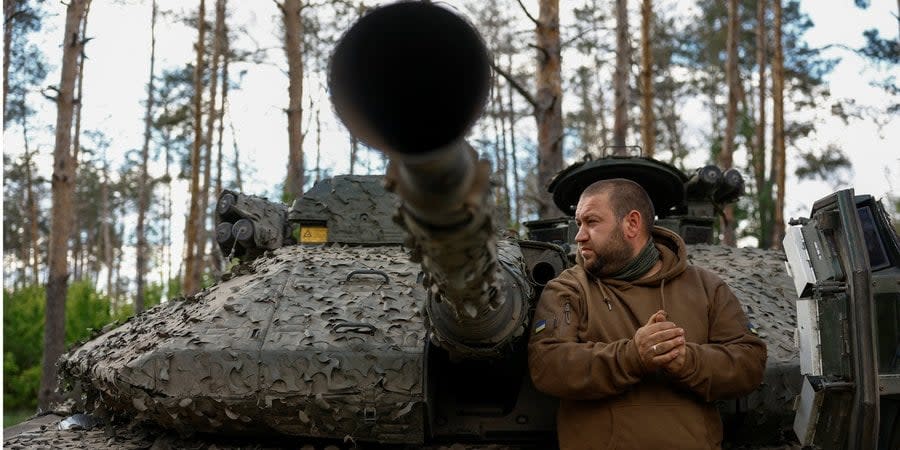White House braces for ‘critical’ months as Russia’s momentum shifts war trajectory — NYT

- Oops!Something went wrong.Please try again later.
- Oops!Something went wrong.Please try again later.
The Biden administration is increasingly concerned about Russia’s current momentum on the battlefield in Ukraine, which could “change the trajectory of the war,” the New York Times reported on May 14.
Read also: Vovchansk faces invasion: Russian forces advance amid ongoing battles – Bild
Citing multiple sources within official circles of the United States and allied countries, the NYT highlights how just a year and a half ago, White House and Pentagon officials debated whether Russian forces in Ukraine might collapse and be pushed out of the country entirely.
Now the Biden administration is concerned that Russian dictator Vladimir Putin could reverse his "once-bleak prospects," the NYT said.
In private, come of President Biden's aides worry that Putin, like the United States, has learned key lessons from the war, particularly about technologies that work and those that do not. The biggest concern is that as Russia replaces weaponry wiped out during the first 27 months of the war, Putin could regain positions just as Biden prepares to meet his closest allies at the Group of Seven (G7) summit in Italy in June. It is unclear whether Biden will be able to repeat the claim he made in Finland last summer, that Putin "has already lost that war," the NYT said.
Biden continues to reject the proposal to deploy Western troops in Ukraine, a proposal supported by French President Emmanuel Macron, the NYT sources said.
The NYT cites opinions from various analysts, including Stephen Hadley, the national security adviser under President George W. Bush administration, who noted that Russia's current momentum is due to several factors:
Delay in U.S. funding, allowing Russia to achieve "huge artillery advantage" over Ukrainian forces
Lack of air defense ammunition allowing Russia to use its air power with more impunity, attacking Ukrainian lines with glide bombs
Delay in the mobilization law in Ukraine, acute shortage of soldiers in the Ukrainian Armed Forces, and problems with adequately training those recruited into the army.
Technological innovations by Russia on the battlefield, particularly the expansion of electronic warfare capabilities, hindering artillery and drones provided by the United States and other NATO countries
"These battlefield advantages are ephemeral, of course, and the war may look as different 18 months from now as it does from 18 months ago," the NYT said.
"But there is a growing sense inside the Biden administration that the next few months could prove critical, because at some moment the two sides may finally move to a negotiated cease-fire, an armistice similar to the one that ended the active fighting in Korea in 1953 — or simply a frozen conflict."
Read also: U.S. looking to send another Patriot system to Ukraine, Europe also looking at options
But all those Russian advantages will not last indefinitely, and Russian forces are likely to make another push on the front this summer, said Michael Kofman, a Russia expert and the Carnegie Endowment for International Peace.
"In 2024, the Russian military enjoys a material advantage, and the strategic initiative, though it may not be decisive," said Kofman.
"This year represents a window of opportunity for Russia. But if the Russian military is not able to turn these advantages into battlefield gains and generate momentum, there is a fair chance that this window will begin to close as we enter 2025."
This "Russia's new momentum" is most evident in the Kharkiv Oblast, where Russia is trying to create a so-called "buffer zone."
Formally, Putin describes its purpose as complicating cross-border raids from Ukraine. However, some experts warn that Moscow's real strategic goal in seizing territories around Kharkiv is to shift Ukrainian forces, making them reinforce the city and weaken the front line elsewhere. This could create an opportunity for another Russian advance on the Donbas in June, the article said.
Read also: Frontline struggles prompt Zelenskyy to cancel Portugal and Spain trips
"The Russian offensive aim is likely to draw Ukrainian reserves and elite units, then pin them in Kharkiv, thereby weakening the rest of the front," said Kofman.
The primary Russian objective still remains recapturing the rest of the Donbas."
Whether the Russians will succeed may partly depend on how successful Ukraine's conscription efforts will be, the NYT said.
Meanwhile, the U.S. is attempting to bolster technical consultations with Kyiv, hoping to counter Russian technological achievements. In some cases, Russia has managed to interfere with the targeting of Ukrainian weapons, influencing GPS receivers. Notably, this has degraded the accuracy of missiles fired from HIMARS launchers.
There aren't many HIMARS launchers in the Ukrainian Armed Forces, but the Russians have had some success in tracking their movements. In some cases, even well-camouflaged launchers have been destroyed, the NYT said.
We’re bringing the voice of Ukraine to the world. Support us with a one-time donation, or become a Patron!
Read the original article on The New Voice of Ukraine

